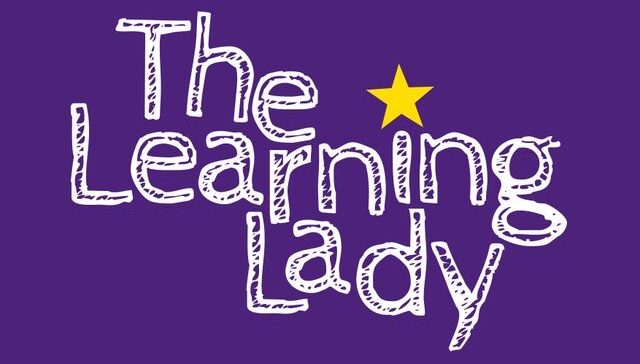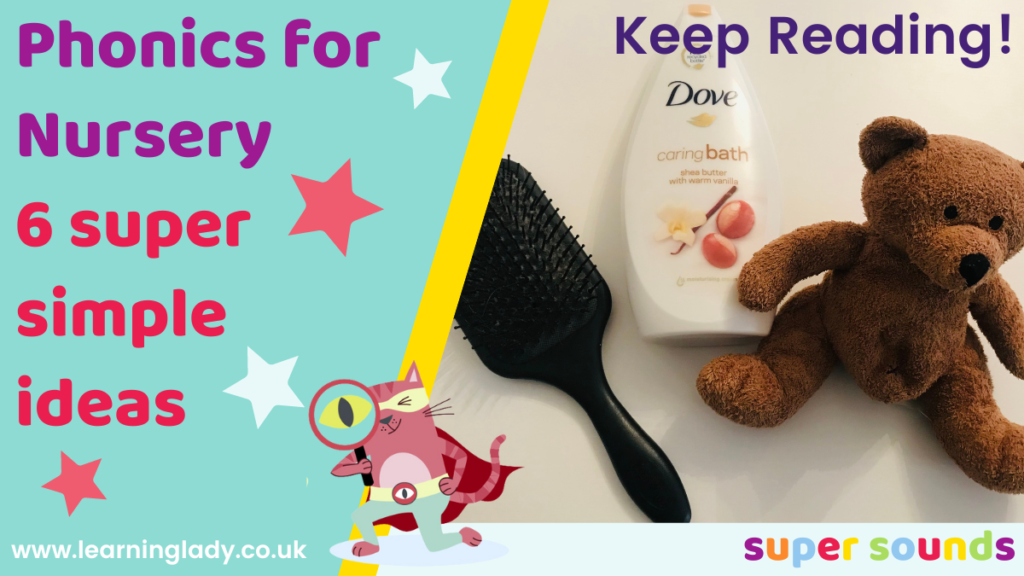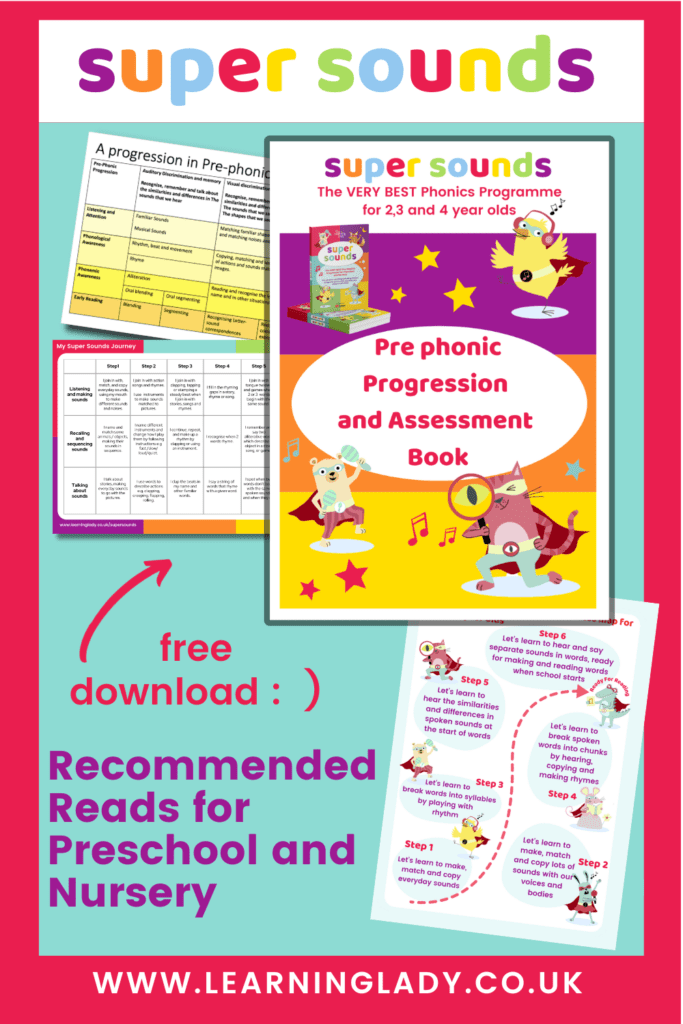An awareness of alliteration is an essential part of phonics for nursery, but where do we start and what should this look like?
The staff at Little Learners Nursery had been developing their nursery phonics activities but they were anxious about alliteration.
This is the story of how we pimped up their provision for perfectly prepared preschoolers!
What Is Alliteration?
Developing an awareness of alliteration as part of nursery phonics is often misunderstood.
It can be easy to assume that teaching alliteration in nursery is about teaching initial sounds. Perhaps by introducing a collection of objects or pictures that all begin with the same sound like:
- Sock
- Sack
- Sandwich
- Slippers
But this isn’t what alliteration is at all.
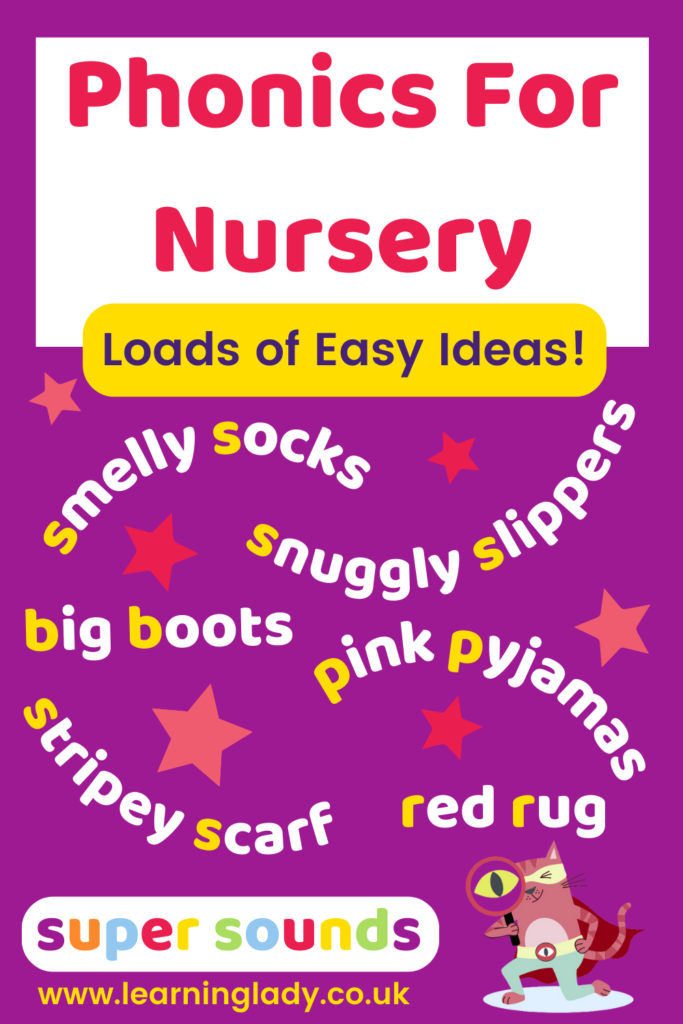
Alliteration actually occurs when two or more words next to each other, in a phrase or sentence, begin with the same spoken sound.
Smelly Sock
Santa’s Sack
Salad Sandwich
Snuggly Slippers
Why should phonics for 3-year-olds include alliteration?
Developing a sense of alliteration is a vital element of phonics for 3-year-olds. It helps to improve phonemic awareness, which is the process of isolating single spoken sounds in words.
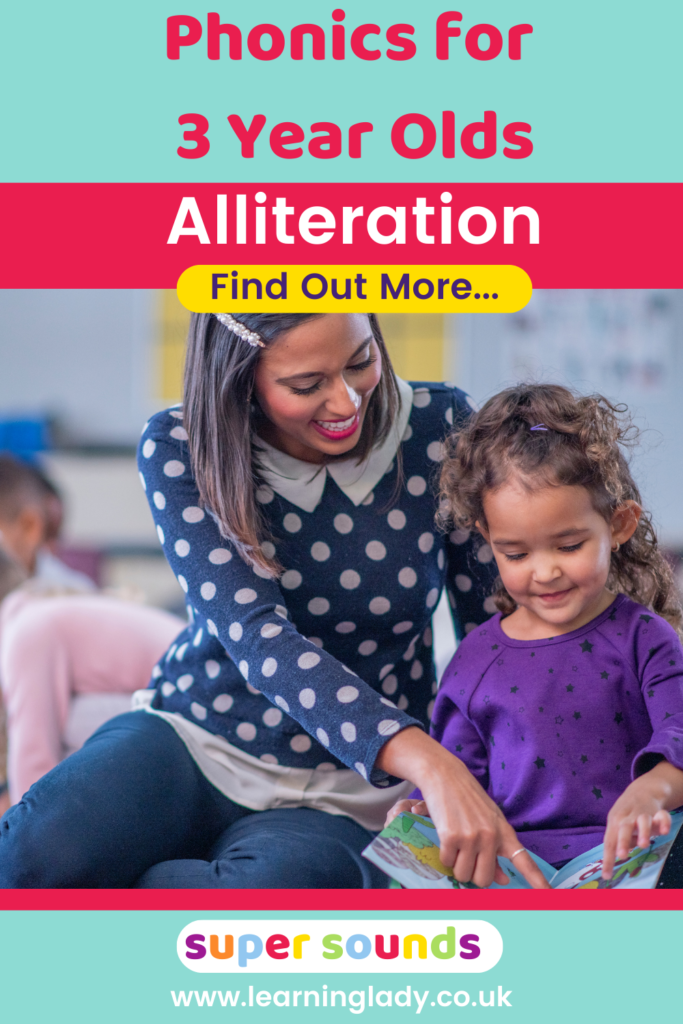

Preschoolers developing an awareness of alliteration are learning to listening out for similarities and differences in spoken sounds at the beginning of words. This is much easier to do when the words next to each other begin with the same spoken sound.
When we play alliteration games with 3- and 4-year-olds during nursery phonics, they begin to ‘tune in’ to the spoken sounds that words are made of. This is an essential step towards reading, when they’ll be tasked with hearing and saying all of the separate spoken sounds in words.
More than just hearing sounds!
Saying phrases or simple sentences where all the words begin with the same spoken sounds are a bit of a mouth full!
This can also help with developing clarity of speech sounds too. Brilliant exercise for the mouth muscles and, in the end, improved communication.
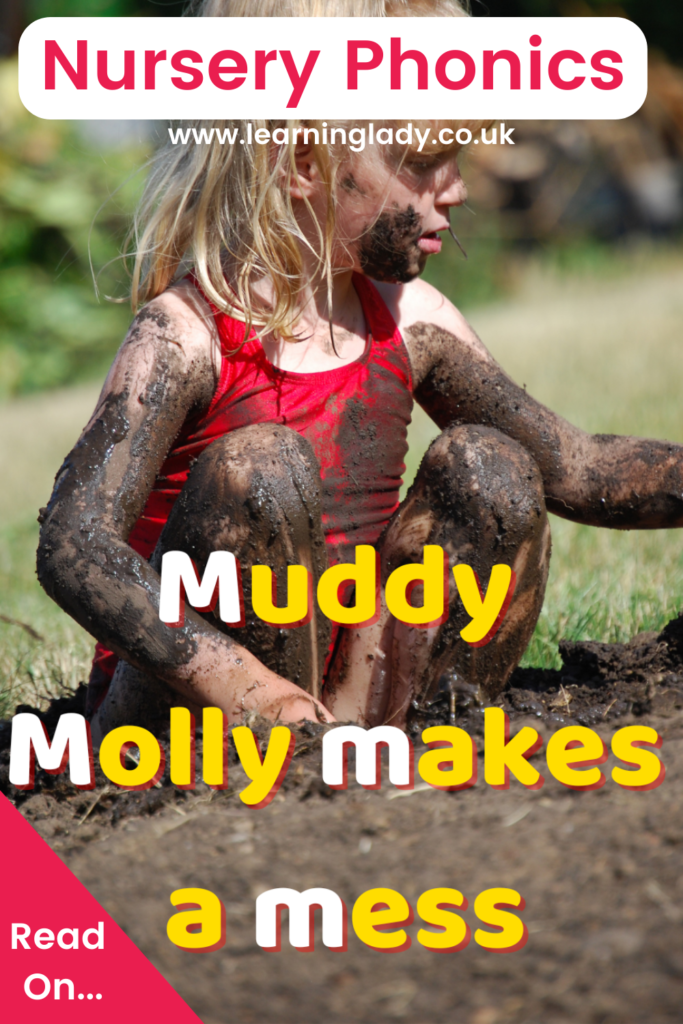
Alliteration Nursery Activities for 4-year-olds
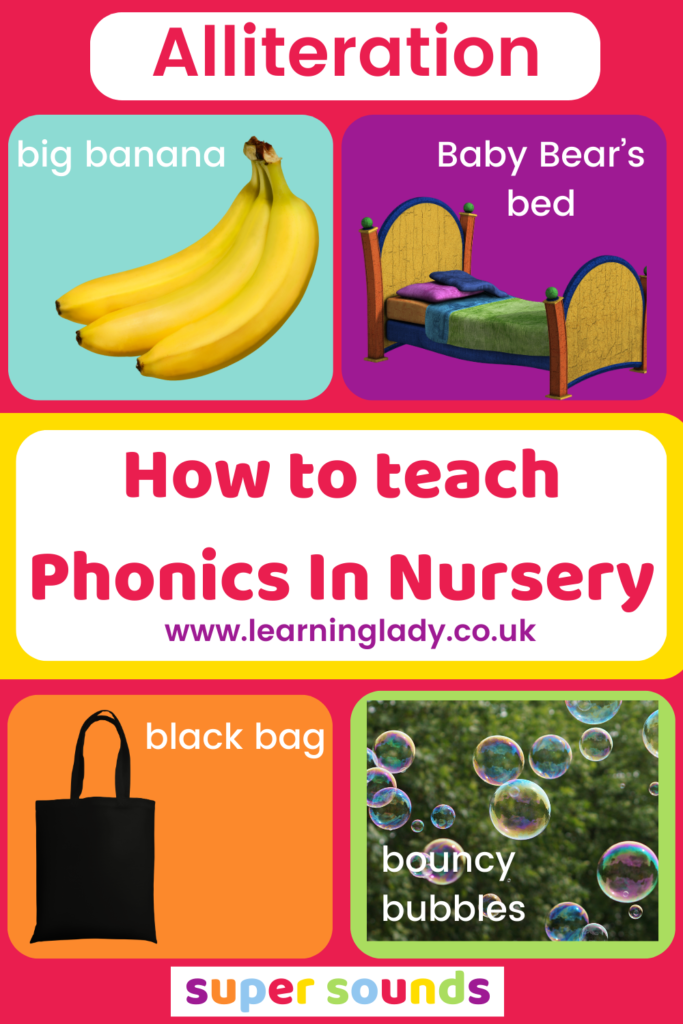
Alliteration nursery activities for 4 year olds involve putting words beginning with the same sounds together. This includes building a vocabulary of different types of words. A list of words beginning with the same spoken sound are likely to be names of objects, people or actions like:
BananaBed
Bag
Blow
Alliteration activities provide the perfect opportunity to model and extend descriptive language or words matched to concepts like;
- Big banana
- Bouncy bed
- Black bag
- Blowing bubbles
Learn more about how to teach phonics in nursery using alliteration
If you’re new to alliteration and are keen to learn more about how to teach phonics in nursery, then this super speedy explainer video is for you.
Find out more about what alliteration is, and how this helps to prepare our preschoolers for phonics when they begin school.
Nursery Phonics at Little Learners
My work at Little Learners began with a professional development hour, where the staff raised concerns about the challenges of nursery phonics, particularly introducing alliteration.
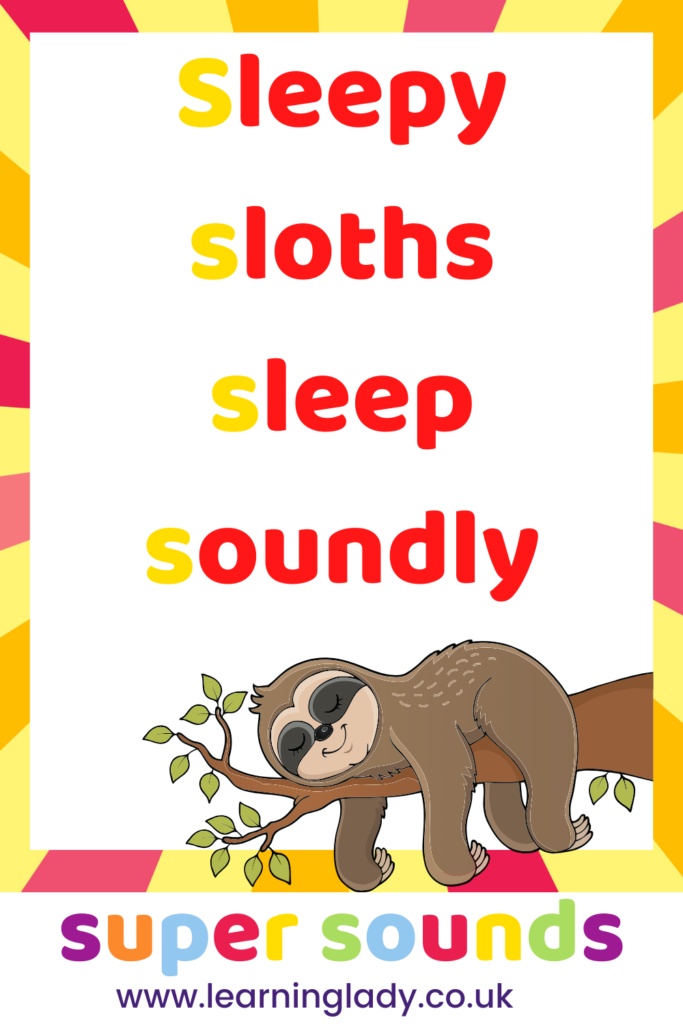
Staff raised issues that we can all relate to:
- Will the parents understand the benefits? They are more ambitious to see letters introduced?
- How could the staff introduce this prephonics concept without confusing themselves and the children?
We began by demystifying what alliteration in nursery means, then working out which of the children had the current skills to get started.
Phonics in Nursery- A super simple progression
All phonics in nursery needs to folllow a simple progression of prephonic skills. This ensures preschoolers experience success at every step along the way.
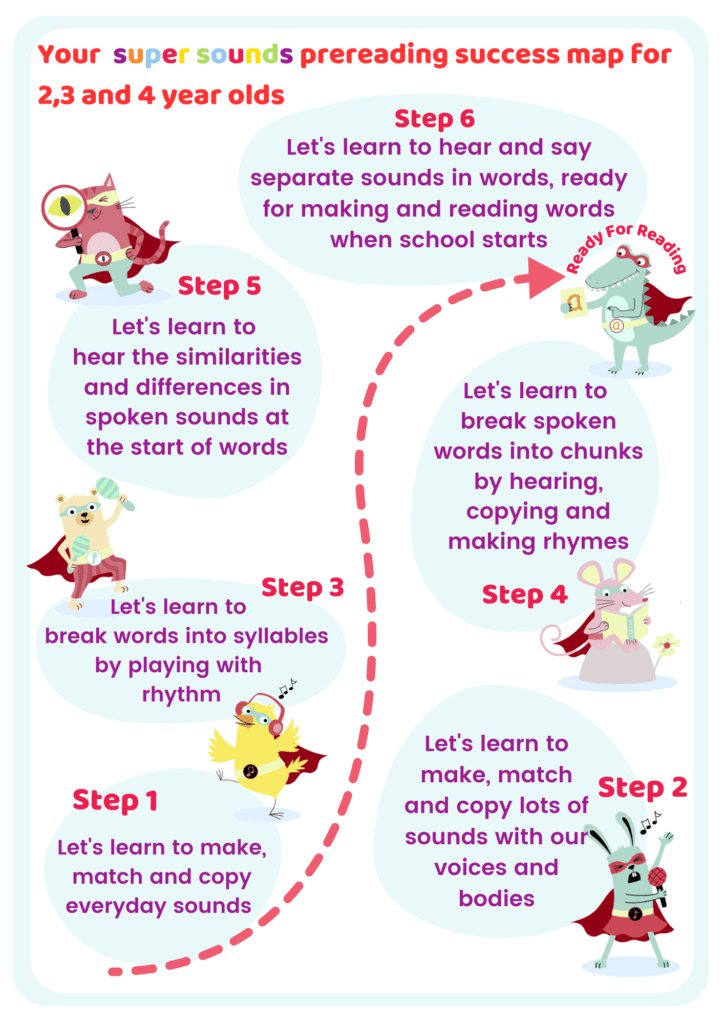
Alliteration is a developmental stage towards the end of the preschool phonics journey and there’s lots that nursery children need to know and do before they get to this stage.
To be ready to hear and use alliteration in words, our children need to be able to:
- Hear, remember, and make similar and different sounds in everyday situations.
- Chunk spoken words up into syllables or ‘beats’.
- Hear similarities and differences of spoken sounds at different points in words by rhyming.
- Know and use simple everyday words for people, objects, and actions.
Getting started with alliteration in Nursery
If you’re wondering if your nursery super stars are ready for alliteration, download this popular FREE assessment tool that Little Learners used.
It will help you pinpoint the nursery phonics skills your preschoolers have mastered so far. Then, like the staff at Little Learners, you’ll instantly be able to see who is ready to play around with alliteration.
It’s reassuringly successful, and a great way of explaining your prephonics programme to parents.
Phonics nursery routines that develop alliteration
At Little Learners, we worked hard to include alliteration into everyday phonics nursery routines.
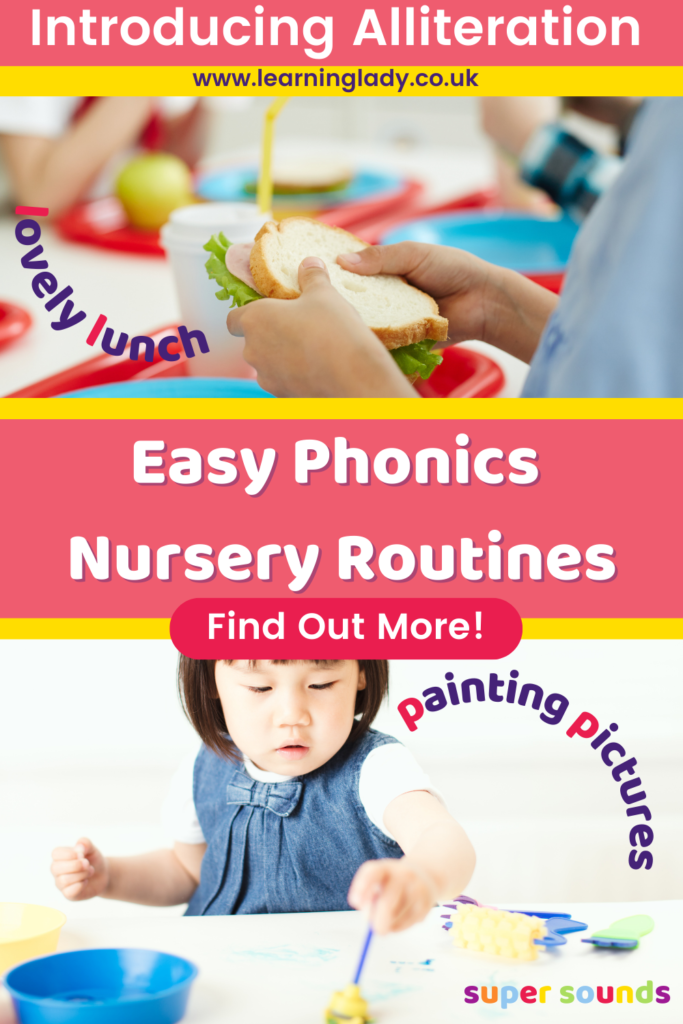
The staff were delighted that there was nothing extra to prepare, but the amount that the children were hearing alliteration increased.
We made a list of all of the routines and daily activities the children participated in. Then, we built these into super simple phrases to add to our everyday conversations.
Here are a few the staff used all the time:
- It’s time to put on our cosy coats
- Here comes our lovely lunch
- It’s super story time
- We love painting pictures
- We are brilliant builders
- Terrific tidying everyone
Easy alliteration resources for Nursery phonics games
As the staff at Little Learners grew in confidence, they kept thinking of everyday examples for developing alliteration. We wanted the children to be playing with what they already knew so that they didn’t need to learn what the objects were. This gave the children the brain space to be thinking about the sounds at the start of the words, rather than naming new and unfamiliar objects.
The Benefits!
Firstly, collecting real objects saved hours of preparation time. It meant that alliteration would be a sustainable part of nursery phonics games every single year.
Secondly, using objects to teach alliteration helps this new concept to stick. When preschoolers see the same objects beyond nursery and preschool, they begin to think about alliteration as part of everyday life.
They start to use the alliterative phrases more, providing plenty of additional practise.
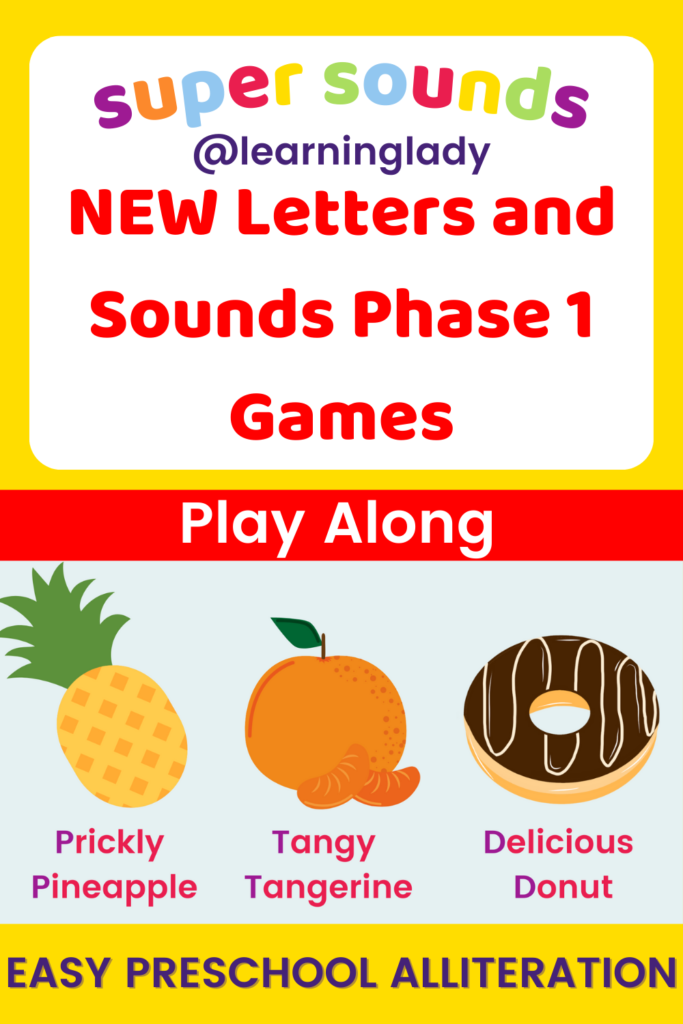
Using books to develop alliteration for better phonics in nursery
The team at Little Learners explained that the term ‘alliteration’ made this simple prephonic skills sound more complicated than it actually is.
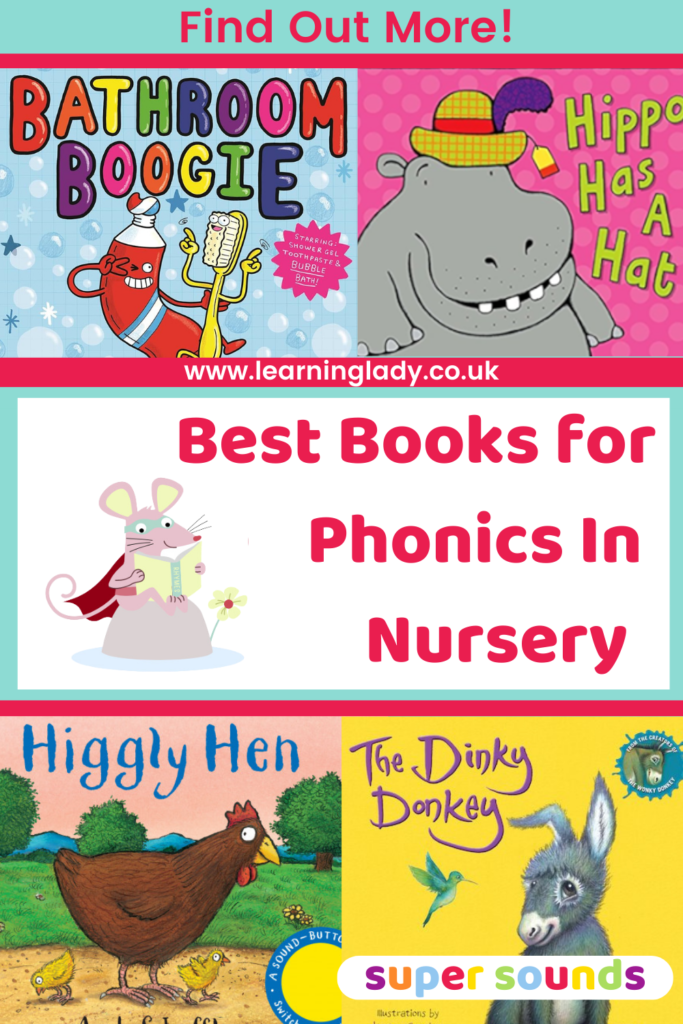
As we explored the concept of alliteration together, everyone began to realise that so many preschool stories, songs, and rhymes have an alliterative element.
Here are some of the books that the children loved to join in with to develop this critical element of phonics in nursery.
Instant Nursery phonics activities for teaching alliteration
Here’s a collection of super simple alliteration games that made a HUGE difference at Little Learners. Add these to your nursery phonics planning today and see the success for yourself!
Alliteration Phonics For Nursery | Supermarket Sort
This game was really popular with the pre-schoolers at Little Learners because it tapped into the daily lives of the children. The staff noticed that, as a result of playing this game, the children became super curious about letters on the packaging. Perfect pre-reading preparation!
What you need
4 or more branded bags from different supermarkets
For example, Asda, Morrison’s, Tesco, Sainsbury’s
Everyday shopping items which begin with the same initial sounds as the supermarket bags
For example, apples (Asda), mushrooms (Morrison’s), toothpaste (Tesco), soup (Sainsbury’s).
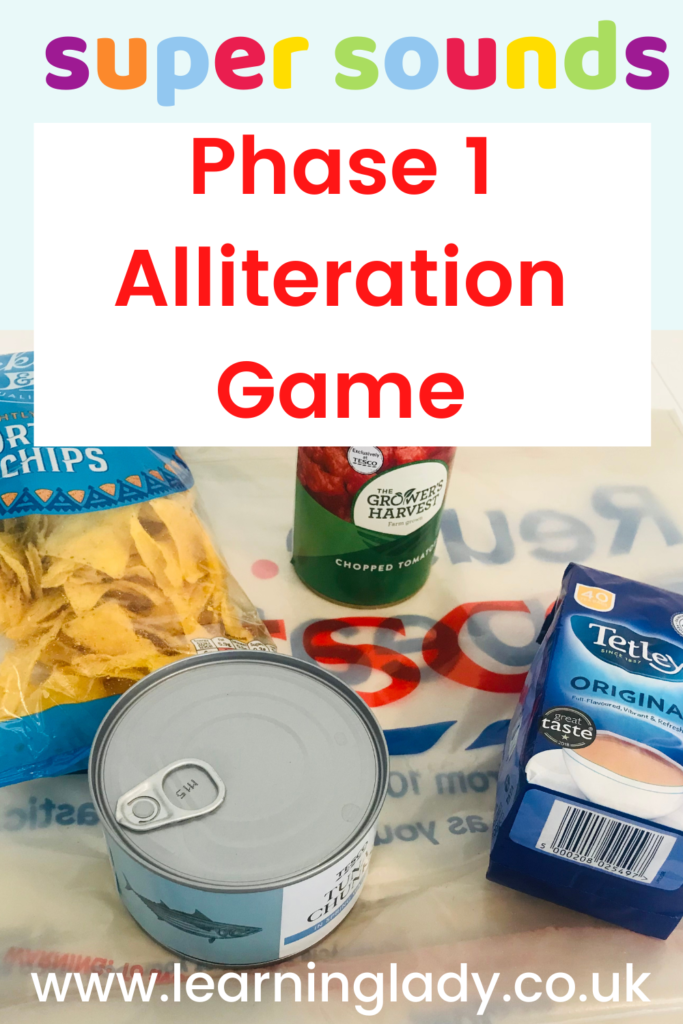
You’ll need up to 6 items to sort for each different supermarket bag used. Place these in a box in the center of the space.
How to play
- Explain that the children are going to be supermarket sorters because the supermarket shopping has been delivered and it’s in a muddle. `
- Introduce the bags from the different supermarkets, emphasising the initial spoken sounds at the beginning of shop names. For example, M-orrisons, S- ainsburys.`
- Explain that the children will need to listen to the first spoken sounds in the objects, matching these with the corresponding shopping bags with the same initial spoken sound. `
- As each child takes an item from the muddled shopping box, encourage the children to name that item all together. Model emphasisng the initial spoken sound with the children joining in. For example, “mmmmmmmmelon”.`
- Can the children work out which bag the melon will go into? For example.
“Could it be mmmmm melon from SssssssSainsbury’s,
mmmmmmmm melon from aaaaaaAsda,
mmmmmmelon from ttttttttTesco or
mmmmmelon from Mmmmmmorrisons?”
- Depending on the confidence and listening ability of the children, work together or encourage them to have a go at working this out as independently. `
- Continue the process, with the children choosing objects to sort into the corresponding bags until all the shopping is organised.
- Can the children think of further items to go in each branded bag?
Alliteration Phonics For Nursery | Magical Words
The children at Little Learners never got tired of playing this magical game. The staff loved how they could adapt the game too. They began with just 2 toys, building up to 4 or 5 as the children became more confident.
Alliteration Phonics For Nursery | Hippo Has a Hat
The preschool children were already used to playing dice games because the staff used these for their prephonics sessions in all kinds of different ways.
Dice games had been particularly helpful for teaching the children to take turns, and this cheap set of dice that the nursery team used were a prized possession!
Hippo Has a Hat was already a firm favourite when the staff introduced this game to the children. This quickly became one of those nursery phonics games that the children would return to again and again.
Alliteration Phonics For Nursery | Twizzle My Tongue
Like all of us, the Little Learner’s team were familiar with tongue twisters, but they had never thought of using these as part of their nursery phonics planning. They used fun and age-appropriate tongue twisters that the nursery children would enjoy learning and saying from memory.
Some of the children struggled with particular tongue twisters because they were still developing clear speech sounds. Others found this challenging just because the spoken sounds were so close together.
The tongue twisters provided a perfect gym workout for the mouth muscles! Just what the nursery children needed to be ready for saying letters matched to sounds in school.
Alliteration Phonics For Nursery | Simple Stories
The staff at Little Learners quickly realised that this game really challenges nursery children to remember. Some of the children found the memory aspect more challenging than the alliteration, so lots of practise was needed!
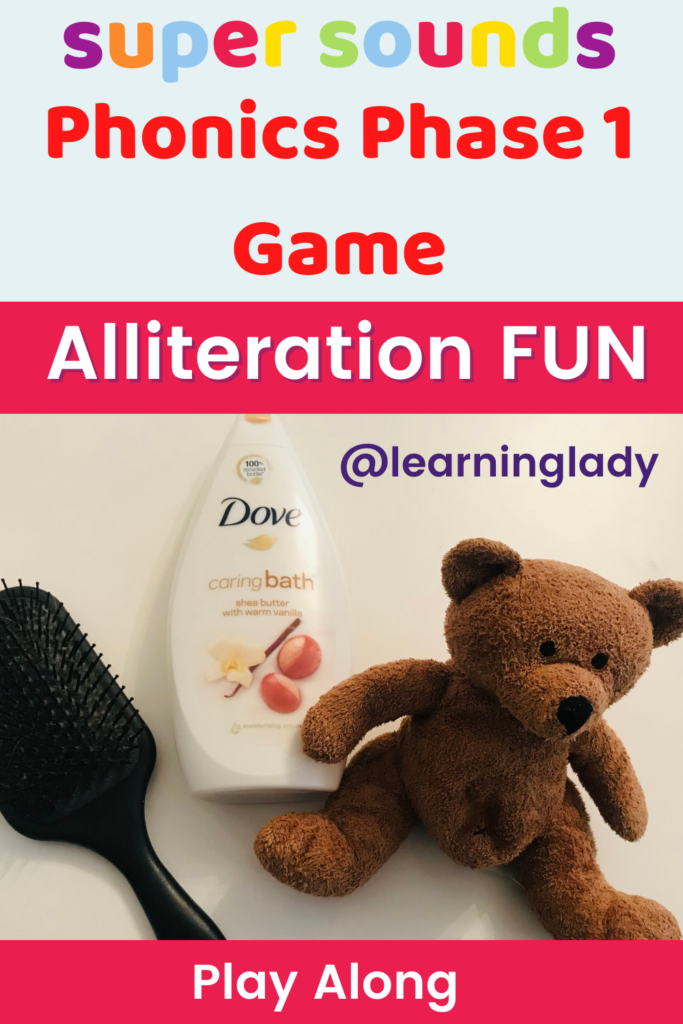
What you need
A collection of items which all begin with the same spoken sound.
For example:
B-ubble b-ath, B-lue b-rush, P-ink p-yjamas, B-ig b-rown b-ear,
S-nuggly S-lippers, T-asty T-oothpaste
How to play
- Explain that you have some bedtime objects in your overnight bag. The children are going to use these for a bedtime storytelling game.
- Introduce each of the objects, checking that the children know what they are.
- Use the allterative phrases to describe the objects. For example, “Pink Pyjamas”.
- Explain that both words begin with the same spoken sound, modelling by exaggerating these as you say the word.
- For example, ppppppppink pppppppyjamas.
- Name each object in this way, encouraging the children to join in all together as they are placed into the bag.
- Begin the simple story by saying aloud: “When I get ready for bed, I need my …….”
- Choose an object from the overnight bag, naming the object aloud as it is placed before the children. “Tasty toothpaste”.
- Encourage the children to repeat the sentence aloud again, all together.
- “When I get ready for bed, I need tasty toothpaste”.
- Choose a child to complete the next part of the story.
- Say the whole initial sentence aloud all together, encouraging as much joining in as possible. For example:
- “When I get ready for bed, I need my tasty toothpaste and……
- As the child takes the next item from the bag, they need to use the two word alliterative phrase to complete the sentence, for example “snuggly slippers”.
- Some children struggle to describe the object beyond one word “slippers”. You will need to repeat and improve on the sentence by saying, “that’s right, you’ve got the slippers, the ssssssnuggly ssssssslippers. “
- List the items taken from the bag so far, naming them aloud with the children joining in all together as you point to the objects:
- For example, “tasty toothpaste, snuggly slippers.”
- Repeat the process as the next child takes an object from the overnight bag and the story building continues.
- “When I get ready for bed I need my tasty toothpaste, snuggly slippers and…… my big brown bear”.
- Continue building up the simple story in this way until the objects have been removed from the overnight bag. Keep modelling and encouraging the children to join in as much as possible, using the real objects to support memory, and vocabulary development, especially as more objects are added to the list.
The Little Learners Journey
As our time of working together drew to a close, the team at Little Learners couldn’t believe the learning journey that they had been on.
The initial anxiety and belief that alliteration is just too hard for Nursery was real.
But the Nursery children had shown the adults that introducing alliteration in nursery is important, super simple and lots of fun!
More Inspiration for Phonics For Nursery
Super Sounds by The Learning Lady
Ready for Reading – Preschool Online Training Course
FREE Recommended Reading books for Preschool Phonics
Alliteration in Nursery | Easy winter activity for preschool
More Tongue Twisters | Easy Phase 1 Phonics activities
Preschool dinosaur Game | Alliteration Phonics Fun
What comes before Phonics by Sally Neaum
